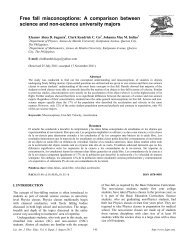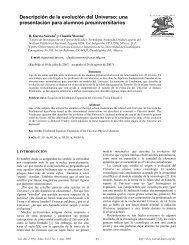Traveling along a zipline
Traveling along a zipline
Traveling along a zipline
You also want an ePaper? Increase the reach of your titles
YUMPU automatically turns print PDFs into web optimized ePapers that Google loves.
<strong>Traveling</strong> <strong>along</strong> a <strong>zipline</strong><br />
Carl E. Mungan 1 and Trevor C. Lipscombe 2<br />
1 Physics Department, U.S. Naval Academy, Annapolis, Maryland, 21402-1363, USA.<br />
2 Catholic University of America Press, Washington, DC, 20064, USA.<br />
E-mail: mungan@usna.edu<br />
(Received 19 November 2010; accepted 31 January 2011)<br />
Abstract<br />
The trajectory of a rider slowly traversing a <strong>zipline</strong> of fixed length and endpoints is computed, as a one-dimensional<br />
illustration of the curving of spacetime by a mass. As the rider’s weight increases from 0 to ∞, the trajectories<br />
uniformly interpolate between a catenary and an ellipse. These results are obtained by balancing forces in the<br />
horizontal and vertical directions, so that the treatment is accessible to undergraduate physics majors who have been<br />
exposed to finding the numerical roots of an algebraic equation.<br />
Keywords: Zipline, curved spacetime, force balance, catenary.<br />
Resumen<br />
La trayectoria de un jinete lentamente atravesando una tirolesa de longitud fija y criterios de valoración se calcula,<br />
como una ilustración de una dimensión de la curvatura del espacio-tiempo por una masa. A medida que aumenta el<br />
peso del ciclista de 0 a, las trayectorias de manera uniforme interpolar entre una catenaria y una elipse. Estos resultados<br />
se obtienen al equilibrar las fuerzas en las direcciones horizontal y vertical, de modo que el tratamiento es accesible<br />
para mayores de física de pregrado que han estado expuestos a la búsqueda de las raíces numérica de una ecuación<br />
algebraica.<br />
I. INTRODUCTION<br />
Palabras clave: Tirolesa, espacio-tiempo curvado, balance de la fuerza, la catenaria.<br />
PACS: 45.20.D–, 46.05.+b, 02.40.-k ISSN 1870-9095<br />
Consider a uniform-density cable of total mass m and length<br />
L. (Nonuniform cables can also be treated [1, 2].) Suppose<br />
one end is fixed at the origin of a coordinate system with the<br />
x axis pointing rightward toward the other fixed end that is<br />
assumed to be lower (or equal) in height than it. Defining the<br />
y axis to point downward, this second end is thus at position<br />
( XY , ) where X 0 and Y 0 such that the cable is not<br />
taut (i.e.,<br />
2 2 2<br />
L X Y ). The cable freely hangs in a<br />
uniform gravitational field g. A person of mass M now clips<br />
onto the cable near the origin and pulls himself <strong>along</strong> the<br />
resulting <strong>zipline</strong> to the far end. The problem consists in<br />
finding the path of the person’s center of mass as he<br />
traverses the line, as a way of introducing the idea of curved<br />
space in general relativity [3, 4]. That is to say, the particle<br />
(rider) is moving in a curved space (the <strong>zipline</strong>) but the<br />
curvature of the space is distorted by the position of the<br />
particle, thereby illustrating John Wheeler’s maxim that<br />
―spacetime tells matter how to move, while the moving<br />
matter tells spacetime how to curve‖ and providing a onedimensional<br />
(1D) analogy [5] to the 2D illustration of a<br />
heavy marble rolling around on a stretched rubber sheet [6].<br />
A 1D model has the advantage that it is relatively<br />
straightforward to calculate and plot.<br />
The article is organized as follows. First, a relation is<br />
found between the tension in the cable at any point <strong>along</strong> the<br />
line and the angle the cable makes with the horizontal at that<br />
same point. Next, the coordinates of the rider (relative to the<br />
left-hand end of the cable) are expressed in terms of his<br />
fractional distance <strong>along</strong> the cable and two dimensionless<br />
parameters characterizing the <strong>zipline</strong>. By letting that<br />
fractional distance equal unity, the coordinates of the righthand<br />
end of the cable are found. Finally, by similarly<br />
calculating the coordinates of the rider relative to the righthand<br />
end of the cable, the rider’s trajectory is numerically<br />
computed (using a root-finding algorithm) by matching the<br />
coordinates determined relative to the two ends of the cable.<br />
The last section of the paper establishes the limiting cases<br />
wherein the trajectory becomes hyperbolic (i.e., the familiar<br />
catenary solution) in the limit of a low-weight rider (relative<br />
to the cable’s weight) and elliptical in the opposite limit of a<br />
heavy rider.<br />
II. CALCULATING THE TRAJECTORY OF THE<br />
RIDER<br />
Consider the situation when the rider is located at position<br />
( x , y ) , a fraction f of the distance <strong>along</strong> the cable’s length.<br />
Lat. Am. J. Phys. Educ. Vol. 5, No. 1, March 2011 5 http://www.lajpe.org<br />
r r
Carl E. Mungan and Trevor C. Lipscombe<br />
The cable bows downward in smooth curves to the left and<br />
right of the person, but there will be a cusp in the <strong>zipline</strong> at<br />
the person’s position [7], as illustrated in Fig. 1. At any point<br />
( xy , ) <strong>along</strong> the cable, the line to the right of that point<br />
makes angle relative to the +x axis. In particular, the<br />
<strong>zipline</strong> makes angle 0 at the end attached to the origin.<br />
FIGURE 1. Geometry of the <strong>zipline</strong> indicating the coordinates of<br />
the two endpoints at (0,0) and ( XY , ) , of the rider of mass M at<br />
( xr, y r)<br />
, and of arbitrary points ( xy , ) and ( x, y ) <strong>along</strong> the line to<br />
the left and right of the rider, respectively. The particular case<br />
plotted here is for parameters i 45 and f 10 (before the<br />
rider mounts the line), 1 (i.e., the rider has the same total mass<br />
as the <strong>zipline</strong>), L 1 (i.e., the <strong>zipline</strong> has unit length), and<br />
f 0.25 (i.e, the rider is located a quarter of the way <strong>along</strong> the<br />
length of the cable). As explained in Sec. III, the <strong>zipline</strong> has the<br />
shape of one catenary between points (0,0) and<br />
another catenary between ( xr, y r)<br />
and ( XY , ) .<br />
( xr, y r)<br />
, and<br />
Now consider the segment of the cable extending from the<br />
origin to the point ( xy , ) a distance <strong>along</strong> it. (Assume<br />
fL so that the segment does not include the rider.)<br />
There are three forces on this segment: the tensions T 0 and T<br />
at its two ends, pulling tangential to the line (i.e., at angles<br />
0 and ), and the segment’s weight mg / L . The line is<br />
always in equilibrium, assuming the rider traverses it<br />
slowly. 1 In that case, the three forces must balance. For their<br />
x components, that implies<br />
T0cos0 T cos .<br />
(1)<br />
Therefore the product of the tension and the cosine of the<br />
angle has some constant value K <strong>along</strong> the cable. To rewrite<br />
it as a dimensionless constant, define b mg / K , so that<br />
T cos mg / b .<br />
(2)<br />
Similarly, balancing the y components of the forces on the<br />
segment implies<br />
T0sin 0 T sin mg . (3)<br />
L<br />
Next, divide Eq. (3) by (2) —or alternatively by Eq. (1)— to<br />
eliminate the tensions and obtain<br />
tan 0 tan b .<br />
(4)<br />
L<br />
Defining another dimensionless constant a tan 0 and a<br />
dimensionless variable u / L , Eq. (4) becomes<br />
tan a bu .<br />
(5)<br />
The coordinates of the rider can be found by dividing the<br />
cable to the left of him into differential pieces of length d .<br />
Integrating the x-components of the length of each piece<br />
gives<br />
fL<br />
xr dl cos .<br />
(6)<br />
0<br />
Divide both sides of this equation by the total length L of the<br />
cable to obtain the normalized x-coordinate of the rider as<br />
f<br />
x du cos .<br />
(7)<br />
0<br />
Substituting Eq. (5) into the identity<br />
2 1/2<br />
cos 1/ sec (1 tan ) , the integral in Eq. (7) can<br />
be performed to obtain the natural logarithm<br />
2<br />
1 a 1 a<br />
ln .<br />
b 2<br />
a bf 1 ( a bf )<br />
1<br />
Here “slowly” means the rider’s acceleration is negligible and his speed<br />
is always much less than the speed of even the slowest transverse waves on<br />
the <strong>zipline</strong>, i.e., Tmin L / m where T min is the tension in the cable at<br />
the point where it makes the smallest angle relative to the horizontal,<br />
rider,<br />
sin<br />
y , can be obtained by replacing cos with<br />
2 1/2<br />
(1 cos ) in Eq. (7), and the resulting integral<br />
according to Eq. (1). This idea of slowness is analogous to the requirement<br />
that the speed of a piston in a gas-filled cylinder must always be much less<br />
than the speed of sound of the gas if the compressions are to be considered<br />
quasistatic.<br />
this time gives<br />
Lat. Am. J. Phys. Educ. Vol. 5, No. 1, March 2011 6 http://www.lajpe.org<br />
x<br />
If there is no rider on the <strong>zipline</strong>, then this relation is valid<br />
<strong>along</strong> its entire length, in which case f 1.<br />
Then defining<br />
X X / L , Eq. (8) becomes<br />
2<br />
0 1 0<br />
1 a a<br />
X ln ,<br />
b a b a b<br />
0 2<br />
0 0 1 ( 0 0 )<br />
where zero subscripts were added to the two constants a and<br />
b to indicate that these are their values when the rider has<br />
zero mass. Similarly, the normalized y-coordinate of the<br />
(8)<br />
(9)
y<br />
2 2<br />
1 a 1 ( a bf )<br />
b<br />
.<br />
(10)<br />
Again, with no rider on the line, put f<br />
obtain<br />
1 and Y Y / L to<br />
Y<br />
2 2<br />
0 0 0<br />
1 a 1 ( a b )<br />
b<br />
0<br />
.<br />
(11)<br />
Equations (9) and (11) cannot be analytically inverted to find<br />
a 0 and b 0 in terms of X and Y . So rather than spelling out<br />
the solution to the problem in terms of the position ( XY , ) of<br />
the right-hand end of the cable, it makes more sense to write<br />
it in terms of the angles i and f that the cable makes at its<br />
two ends without a rider. 2 Recalling the definition of a and<br />
solving Eq. (4) for b, one can write<br />
a and b 0 tan i tan f . (12)<br />
0 tan i<br />
Then the (normalized) position of the right end of the cable<br />
can be determined from Eqs. (9) and (11). That position<br />
remains fixed as the rider mounts the cable, as does the<br />
length of the cable. But the values of a and b change and are<br />
no longer equal to a 0 and b 0 , because the shape (and hence<br />
the two end angles) of the cable change with a rider present.<br />
In fact, it is clear that even for a fixed (nonzero) rider mass,<br />
the values of these two parameters vary as the person<br />
changes position f <strong>along</strong> the <strong>zipline</strong>. So the problem now<br />
becomes one of finding the values of a and b for a given<br />
rider position f and mass M (expressed in normalized form as<br />
M / m relative to the cable’s mass). The key to solving<br />
this problem is that Eqs. (8) and (10) give the position ( xy , )<br />
of the cable at the rider’s position relative to the left-hand<br />
end of the cable (in terms of the unknowns a and b). Similar<br />
equations (in terms of the same two unknowns) give the<br />
position ( x, y ) of the right-hand end of the cable relative to<br />
the rider. 3 By imposing the constraints x x X and<br />
y y Y , two equations are obtained in the two unknowns<br />
and a root-finding algorithm can be used to solve for a and b.<br />
The first step is to find the angle 0 of the cable<br />
immediately to the right of the rider. For this purpose,<br />
consider a segment of the cable that starts at the origin and<br />
just barely extends beyond the rider’s point of attachment.<br />
Equation (3) can be modified in this case by adding the<br />
rider’s weight Mg to the right-hand side,<br />
T0 sin 0 T0 sin 0 mgf Mg , (13)<br />
<strong>Traveling</strong> <strong>along</strong> a <strong>zipline</strong><br />
where became the rider’s position fL, angle became<br />
0 , and likewise for the tension T. Again divide this<br />
equation by Eq. (2) to get<br />
tan 0 tan 0 bf b .<br />
(14)<br />
Consequently the parameter corresponding to a for the righthand<br />
segment of the cable is<br />
a a bf b .<br />
(15)<br />
Unlike Eq. (3), however, Eq. (1) remains valid even when<br />
the point ( xy , ) in Fig. 1 is moved to the right of the rider,<br />
because the rider’s gravitational force does not have an x<br />
component. Thus K has the same value on the left-hand and<br />
right-hand segments of the <strong>zipline</strong>. Therefore the parameter<br />
corresponding to b for the right-hand segment is unchanged,<br />
b b. Finally, the sum of the lengths of the left-hand and<br />
right-hand segments of the cable must be L, and thus the<br />
parameter corresponding to f for the right-hand segment<br />
must be f 1 f . Now simply substitute these values of<br />
a , b , and f in place of a, b, and f in Eqs. (8) and (10) to<br />
get<br />
and<br />
x<br />
y<br />
2<br />
1 a bf b 1 ( a bf b )<br />
ln ,<br />
b 2<br />
a b b 1 ( a b b)<br />
2 2<br />
1 ( a bf b ) 1 ( a b b)<br />
b<br />
.<br />
(16)<br />
(17)<br />
The sum of Eqs. (8) and (16) is set equal to Eq. (9), and the<br />
sum of Eqs. (10) and (17) to Eq. (11) and the command<br />
―FindRoot‖ in Mathematica is used to solve for a and b for<br />
given values of and f. Figure 2 plots the results for equal<br />
to 0, 0.1, 0.5, 1, 2, and ∞ with f varying from 0 to 1 in steps<br />
of 0.01. As explained next, these trajectories interpolate<br />
between a catenary and an ellipse as increases in value.<br />
2<br />
Note that the angle anywhere <strong>along</strong> the cable (including its two ends),<br />
with or without a (finite-mass) rider, is limited to the range 90 90<br />
since the line can never become vertical according to Eq. (2). Within that<br />
range, tan is always finite and is a single-valued function of .<br />
FIGURE 2. Trajectories followed by the rider through space for six<br />
3<br />
Hereafter, primes are consistently used to indicate parameters of the cable different values of (ratio of the masses of the rider and of the<br />
segment to the right of the rider that correspond to the unprimed parameters<br />
of the cable segment to his left.<br />
<strong>zipline</strong>) indicated in the legend, for parameters i 45 ,<br />
Lat. Am. J. Phys. Educ. Vol. 5, No. 1, March 2011 7 http://www.lajpe.org
Carl E. Mungan and Trevor C. Lipscombe<br />
f 10 , and L 1 so that X 0.898389 and Y 0.339010 .<br />
The limiting cases are 0 for which the trajectory is a catenary,<br />
and for which the trajectory is an ellipse, as explained in<br />
Sec. III. (For the case of , there are short vertical segments at<br />
the two ends of the trajectory, whose lengths are determined by<br />
requiring the <strong>zipline</strong> to tauten when the rider clips on.) Do not<br />
confuse these trajectories of the rider with the shapes of the <strong>zipline</strong><br />
for a fixed position of the rider (as shown in Fig. 1 for example).<br />
III. SHAPE OF ANY PIECE OF THE CABLE<br />
THAT DOES NOT INCLUDE THE RIDER<br />
Equation (8) can be inverted to obtain f in terms of x . That<br />
expression can then be substituted into Eq. (10) to obtain<br />
y<br />
1<br />
2<br />
a cosh ln a 1<br />
2<br />
a bx<br />
b<br />
.<br />
(18)<br />
Therefore, any piece of the cable that does not include the<br />
rider’s point of attachment is a catenary [8]. An alternative<br />
way to derive this result is to rewrite Eq. (5) as<br />
dy / dx a b / L , differentiate both sides of it with respect<br />
2 1/2<br />
to x, substitute d / dx (1 [ dy / dx ] ) , and finally switch<br />
to normalized coordinates to obtain<br />
2<br />
d y dy<br />
b 1 .<br />
2<br />
dx<br />
dx<br />
2<br />
(19)<br />
By defining z dy / dx with z0a, Eq. (19) can be<br />
integrated twice to get Eq. (18).<br />
For example, suppose a a 0 and b b 0 as given by Eq.<br />
(12). Then Fig. 3 is a plot of Eq. (18) for a unit length of the<br />
cable making angles i 30 and f 0 at its two ends.<br />
The initial end is at the origin and the final end is at position<br />
( XY , ) given by Eqs. (9) and (11).<br />
FIGURE 3. Shape of a rider-free <strong>zipline</strong> (of unit length L 1)<br />
when the angles the line makes (relative to the horizontal) at its two<br />
ends (indicated by the black dots) are i 30 and f 0 . The<br />
curve is a portion of a hyperbolic cosine whose minimum is at the<br />
right-hand endpoint, where X 0.951427 and Y 0.267949 .<br />
If the rider is much heavier than the cable, then the<br />
tension in the <strong>zipline</strong> gets very large and hence b 0 . In<br />
that limit, Eq. (18) reduces to simply y ax . In other words,<br />
the cable consists of one straight segment from the origin to<br />
the rider and a second straight segment from the rider to the<br />
right-hand end. For any given value of f, the rider’s<br />
coordinates can then be determined from the constraint that<br />
the total length of the cable is L. Since the rider moves such<br />
that the sum of his distances to the two endpoints is fixed, he<br />
travels <strong>along</strong> an elliptical trajectory through space. In<br />
contrast, if the rider is much lighter than the cable, then he<br />
hardly distorts its shape and his trajectory is consequently the<br />
catenary described by Eq. (18).<br />
IV. CONCLUSIONS<br />
Traditionally, the problem in a mechanics course of a<br />
hanging cable consists in finding its shape, both theoretically<br />
and experimentally, under a variety of different conditions<br />
including some novel ones [9–11]. The present paper instead<br />
computes the distortion in a <strong>zipline</strong> as a weight slowly<br />
moves <strong>along</strong> its length. As that traveling mass increases from<br />
zero to infinity, the trajectory is found to interpolate between<br />
a hyperbolic cosine and an ellipse, as plotted in Fig. 2.<br />
Instructors or students eager to quickly reproduce that figure<br />
merely have to set the sum of Eqs. (8) and (16) to Eq. (9),<br />
and the sum of Eqs. (10) and (17) to Eq. (11), then use a<br />
numerical solver to find the values of a and b (for any given f<br />
and ). Armed with these values, one can immediately plot<br />
( xy , ) as f is varied from 0 to 1 for fixed .<br />
Remarkably, no numerical technique other than finding<br />
the simultaneous roots of a pair of algebraic equations is<br />
needed to compute these trajectories. Thus this problem is<br />
appropriate for the intermediate classical mechanics course<br />
(traditionally taken in the sophomore or junior undergraduate<br />
years of the physics major). It would make an interesting<br />
student project to actually measure the coordinates of a<br />
hanging weight placed at various positions <strong>along</strong> a<br />
suspended cable and compare it to the present theoretical<br />
results. In addition to extending familiar variational ideas,<br />
the loaded <strong>zipline</strong> has importance as a physical model of<br />
curved space. Further, the results here could be of interest to<br />
actual users of <strong>zipline</strong>s who wish to safely clear obstacles.<br />
REFERENCES<br />
[1] O’Keefe, R., A circular catenary, Am. J. Phys. 64, 660–<br />
661 (1996).<br />
[2] Fallis, M.C., Hanging shapes of nonuniform cables, Am.<br />
J. Phys. 65, 117–122 (1997).<br />
[3] Gruber, R. P., Gruber, A. D., Hamilton, R. and Matthews,<br />
S. M., Space curvature and the “heavy banana paradox”,<br />
Phys. Teach. 29, 147–149 (1991).<br />
[4] Ellingson, J. G., The deflection of light by the Sun due to<br />
three-space curvature, Am. J. Phys. 55, 759–760 (1987).<br />
Lat. Am. J. Phys. Educ. Vol. 5, No. 1, March 2011 8 http://www.lajpe.org
[5] Meckler, A., The hanging string as a model of metric<br />
distortion, Am. J. Phys. 44, 845–850 (1976).<br />
[6] White, G. D. and Walker, M., The shape of “the<br />
Spandex” and orbits upon its surface, Am. J. Phys. 70, 48–<br />
52 (2002).<br />
[7] Zapolsky, H. S., A simple solution of the center loaded<br />
catenary, Am. J. Phys. 58, 1110–1112 (1990).<br />
[8] Nedev, S., The catenary—An ancient problem on the<br />
computer screen, Eur. J. Phys. 21, 451–457 (2000).<br />
<strong>Traveling</strong> <strong>along</strong> a <strong>zipline</strong><br />
[9] Behroozi, F., Mohazzabi, P. and McCrickard, J. P.,<br />
Remarkable shapes of a catenary under the effect of gravity<br />
and surface tension, Am. J. Phys. 62, 1121–1128 (1994).<br />
[10] Silverman, M. P., Strange, W. and Lipscombe, T. C.,<br />
„String theory‟: Equilibrium configurations of a helicoseir,<br />
Eur. J. Phys. 19, 379–387 (1998).<br />
[11] Mareno, A. and English, L. Q., The stability of the<br />
catenary shapes for a hanging cable of unspecified length,<br />
Eur. J. Phys. 30, 97–108 (2009).<br />
Lat. Am. J. Phys. Educ. Vol. 5, No. 1, March 2011 9 http://www.lajpe.org


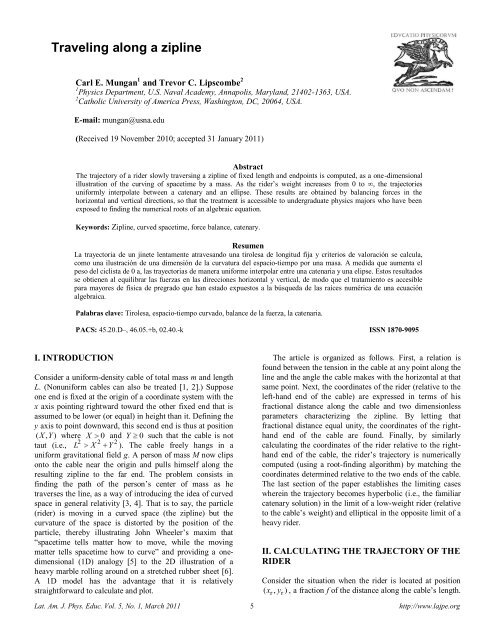
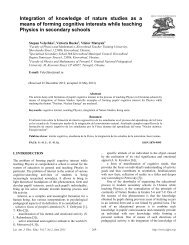
![Diversas formas de visualizar estados en un sistema cuántico [PDF]](https://img.yumpu.com/51151303/1/190x245/diversas-formas-de-visualizar-estados-en-un-sistema-cuantico-pdf.jpg?quality=85)

![Precession and nutation visualized [PDF]](https://img.yumpu.com/50786044/1/190x245/precession-and-nutation-visualized-pdf.jpg?quality=85)
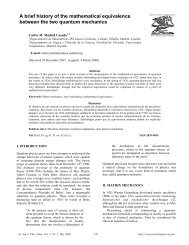
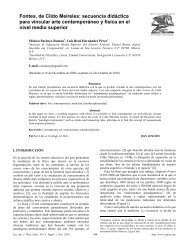
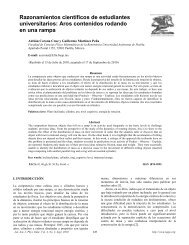

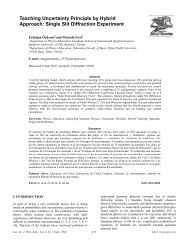
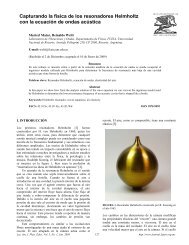
![Index [PDF] - Latin-American Journal of Physics Education](https://img.yumpu.com/47984121/1/190x245/index-pdf-latin-american-journal-of-physics-education.jpg?quality=85)
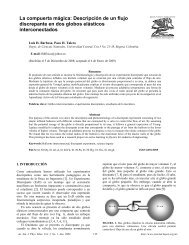
![Flujo de agua en botellas como experimento didáctico [PDF]](https://img.yumpu.com/43536300/1/190x245/flujo-de-agua-en-botellas-como-experimento-didactico-pdf.jpg?quality=85)
